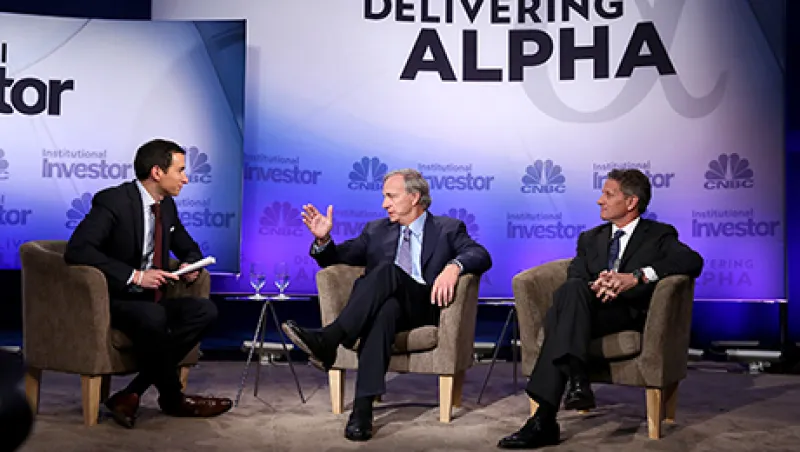Anyone wondering why market volatility has risen lately could have found some answers at Delivering Alpha, the investment conference organized by Institutional Investor and CNBC last week. Some of the biggest names in finance are deeply divided about the fundamental factors driving asset prices.
Paul Singer, the renowned credit investor and founder and president of Elliott Management Corp., told the crowd that the bond market was broken and at risk of a major blowup. Central bankers “have created a tremendous increase in hidden risk” with their bond-buying policies and near-zero, or even negative, interest rates, he argued. Those policies have inflated stock and bond prices to dangerously high levels and run the risk that inflation, now seemingly contained, will soar out of control. Recent market setbacks triggered by speculation of a possible 25-basis-point rate hike by the Federal Reserve was just a “pre-ruckus” of the turmoil ahead, he said, adding, “I think it’s a very dangerous time in the global economy and global financial markets.”
Shortly before Singer sketched out his apocalyptic vision, Ray Dalio, the founder and chairman of hedge fund colossus Bridgewater Associates, offered a much more subdued outlook. Advanced economies are sluggish because of the debt overhang of the financial crisis, with the U.S. capable of sustaining a growth rate of only 1.5 to 2 percent. Far from acting preemptively to ward off hyperinflation, the Fed shouldn’t consider anything but the most modest and gradual of rate hikes, he said; “At this stage the risks are so asymmetric.”
The U.S. economic recovery is in its eighth year, nearly 15 million jobs have been created since the depths of the Great Recession, the Fed’s preferred inflation measure remains below its target, and stock and bond prices are near historic highs after years-long rallies, yet hardly anyone feels good about the state of markets today. The key question is whether today’s sluggish growth, low rates and high asset valuations are largely a consequence of the global financial crisis — Dalio’s stance, which dovetails with the views of most policymakers — or whether excessive central bank activism is largely to blame, as Singer contends.
What’s notable about the recent rise in volatility is that it follows signs of doubt among central bankers themselves. One of the main themes at the Kansas City Federal Reserve Bank’s economic symposium at Jackson Hole last month is that it’s time for fiscal policy to take some of the strain off of monetary policy, which developed economies have relied upon almost exclusively in the postcrisis world. At the European Central Bank’s policy meeting earlier this month, president Mario Draghi refrained from any commitment to extend the ECB’s quantitative easing next year or cut rates further, fueling speculation that the bank was beginning to doubt the efficacy of its policies. Similar concerns are growing about the Bank of Japan, where governor Haruhiko Kuroda has used bond buying and negative rates more aggressively than anyone else, with less than stellar results.
The Bank for International Settlements (BIS), the central bank for the world’s central bankers, cites a “sense of dissonance” in recent market movements in its latest quarterly report, out today. Falling bond yields are normally associated with subdued growth, it points out, yet stock markets around the world have rallied even as corporate profitability has lagged. And nominal yields on ten-year government bonds in the U.S., Japan, Germany and the U.K. have recently been running well below the nominal rate of growth in gross domestic product, breaking a 65-year pattern in which the two have tracked each other closely.
The suggestion is that quantitative easing and zero-to-negative rates have created a positive feedback loop, pushing more investors into longer-dated bonds as part of a global momentum trade. The risk, of course, is that the feedback loop turns negative.
“There has been a distinctly mixed feel to the recent rally — more stick than carrot, more push than pull, more frustration than joy,” says Claudio Borio, chief economist of the Basel-based BIS. “This explains the nagging question of whether market prices fully reflect the risks ahead. Doubts about valuations seem to have taken hold in recent days.” Dubravko Lakos-Bujas, head of U.S. equity and quantitative strategy at J.P. Morgan Securities, said last week that a rise in volatility in U.S. stocks after two months of unusual calm signaled the growing risk of a “deleveraging event” in which investors unload stocks.
It all adds up to a distinctly edgy market environment as the Federal Open Market Committee (FOMC) prepares to hold its policy meeting on Tuesday and Wednesday.
The Fed itself appears more torn that it has been in years. Vice chair Stanley Fischer fueled speculation about a rate rise last month by saying the Fed was getting close to its targets on inflation and unemployment, whereas governor Lael Brainard last week seemed to dampen talk of a rate hike by stressing the weak global environment.
The Fed almost certainly will not make a move this week because expectations aren’t ready, says Vincent Reinhart, chief economist at Standish Mellon Asset Management Co. and a former FOMC economist. The central bank “is willing to disappoint markets, but it’s not willing to surprise markets,” he says. He expects the Fed to make a 25-basis-point hike in December.
Reinhart, like Dalio, is a member of the low-expectations camp. If the economy can grow at only 1.5 to 2 percent, “returns are going to be suppressed,” and investors will continue to stretch for yield. In that environment, he adds, “you’re vulnerable to all sorts of shocks.”
For investors, the summer doldrums are definitely over.
Follow Tom Buerkle on Twitter at @tombuerkle.






